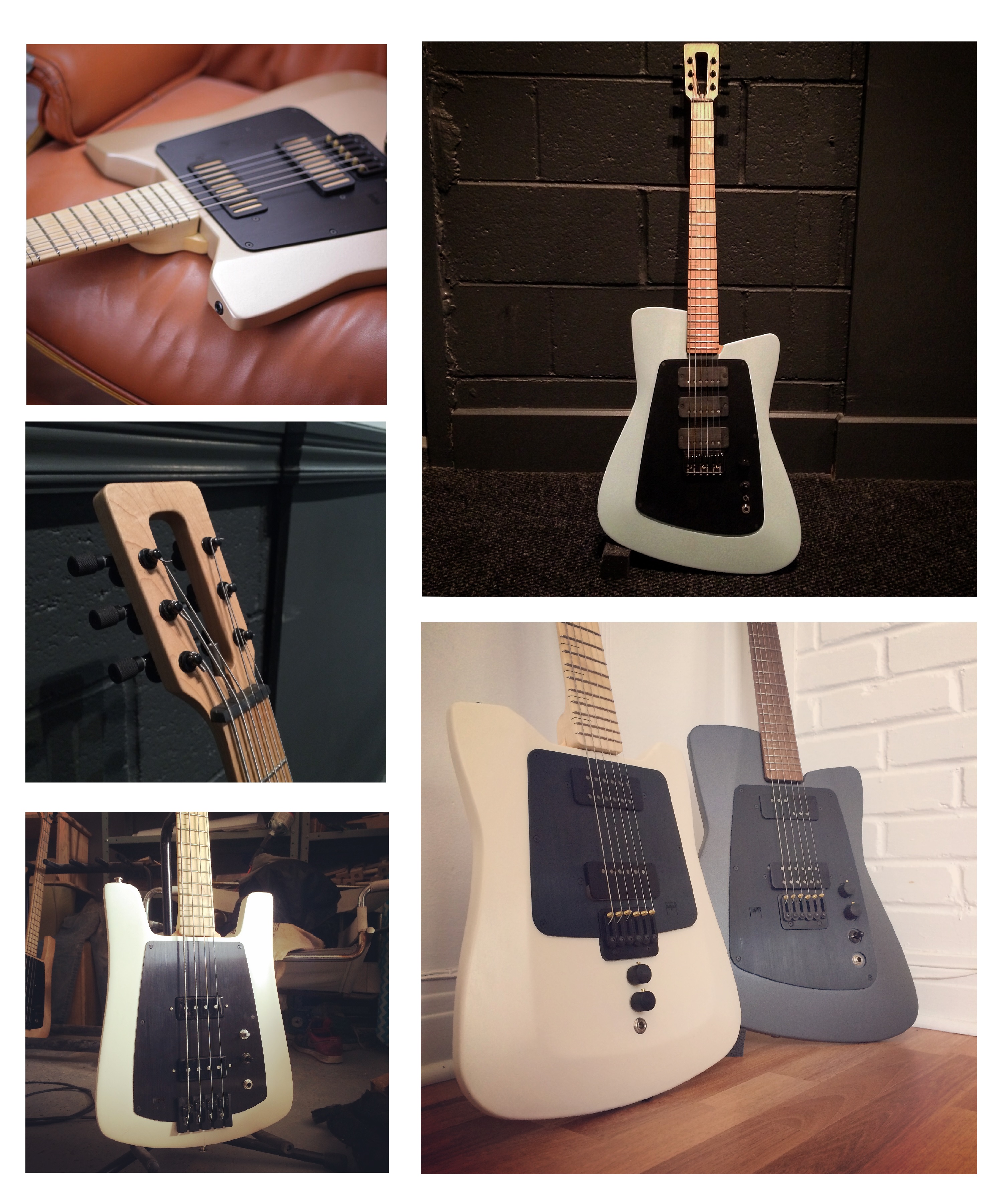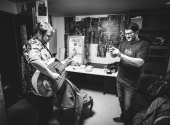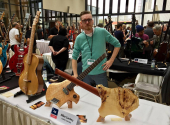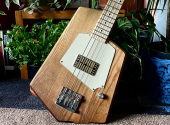
Dreamstruments #4: Florian Bouyou Millimetric Instruments
Making guitars without imitating an established shape tends to be a quick way to failure. The healthy chutzpah of a guitar maker who believes that he has discovered a new guitar world is often misunderstood by the public. In short, one thing is to draw an instrument and convince yourself of the benefits and beauty of the design, quite another is to convince the customer. This article is "about one guy who made it"—Florian Bouyou from Montréal, Canada, has managed to find a novel design language for his brand Millimetric Instruments that in some ways puts him in a unique position. You'll recognise his guitars even if you only know one of his models.
The electric guitar is not an old instrument, the first pieces are celebrating their 90th anniversary this year. Yet, its further development might seem to have stagnated a bit in recent years, as the only innovations are tricks suitable for trade show PR, be it rotary pickups or the use of space technology. The basics tend to be more or less the same.
The problem is simple. Customers are generally conservative, the big brands have their portfolio completed, and how many guitar builders do you know who are also art school graduates? That's how the story of Millimetric Instruments guitars began. "My education is very diverse, but it kind of makes sense now, like a big puzzle that comes together at the end. I started in sales after high school because I did not know what I wanted to do, I did a few internships in music stores, discovered graffiti and started painting on abandoned walls every weekend. Graffiti taught me a lot about shapes and visual language. Then I went to an art school for a year. While still doing graffiti, I started painting on canvas and exhibit my work around bars and small galleries in my home town. Later, I moved to Paris to study at a graphic design school. That's when I started playing the guitar and tinkering with it. After two years, I decided to find a school for luthiery. I applied to Montreal Bruand school but was not accepted, so I chose to go to cabinet-making school. I fell back in love with furniture design and learned a lot about precision work and craft," he adds.

Industrial design, architecture and an old gramophone
Florian started building his first guitars after two and a half years of studying carpentry. He speaks about their design with great enthusiasm and in depth which he would hardly have achieved without his art and design education. He admits his strongest role models, Travis Bean and Obstructures guitars, which he discovered through his love of 90s noise rock icons Shellac and The Jesus Lizard. "When you are trying to create something different, you need to look at a lot of different things, not just guitars, I think that is often the mistake that builders make. I've been inspired by Travis Bean guitars, and I've been very influenced by the return of Fender offsets, but I've also drawn from architecture or industrial design, old and new," he elaborates on his influences. "I think every era has lots of interesting artists and products. Like Dieter Rams, for example. All of his designs, especially in HiFi gear, are super interesting and so well designed," Florian adds.
The back of the Millimetric guitars is quite surprising. They don't have the usual bolt-on neck or glued neck nor the neck-through construction. The design, which uses the aluminium Obstructures, breaks with convention. The neck of the guitar continues under the body and ends under the fingerboard, which allows the strings to be threaded through. It's a sort of hybrid of bolt-on and neck-through construction that also draws inspiration from the band Shellac. "I wanted to get as close to the Shellac sound as possible, I looked for that sound with all my heart, but I didn't want to work with aluminium, so I built my first guitars completely out of maple," Florian recalls. Later, the construction allowed him to achieve a very comfortable upper frets access.

The pitfalls of a specific design vision
Someone said that knowing what you want is the greatest wisdom. But once you know what you want, you also need someone to deliver it. Having a very clear vision of what Millimetric guitars will look like also brings along some complications. First, as Florian says, it limits the customer's ability to "meddle" too much in the final product. That's because, for an instrument to keep its Millimetric mojo, its look has to work according to Florian. "I often refuse client demands because from a design standpoint I don't think it works," he explains. "I want to have fun building those instruments, I want to appreciate each of them after they are done. I think it's important to keep the signature look of my guitars," he clarifies, and let's just say that while everyone may not like it, you don't go to Gibson for a Strat either. The brand has to be built on a unified design vision.
Of course, the look of the hardware is also hugely important for maintaining those visual qualities. "The tuners are from Hipshot, they've been making this type for years. I've been working on pickups with Mike from MJS pickups for over ten years. I have been lucky, every time I have a new idea, he's ready to discuss it and find a way to achieve it," says Florian, immediately mentioning that the bridges and potentiometer covers weren't that simple. "Fortunately, there are tools available now that allow you to experiment a lot and find the best way. I print the knobs on a 3D printer I recently bought and I assemble the bridges from parts that I cut with a laser. Sometimes it's challenging to assemble hardware from only 2D parts, but that's the beauty of it," laughs Florian.

Keeping control
The Millimetric Instruments story could very easily work as a guide for other aspiring guitar builders. Create your own manuscript. Don't just copy guitars, look at the design from different angles and don't be afraid to reach out to someone who can help you with the design and presentation. Don't stray from the path, even at the cost of turning down a client.Florian Bouyou's guitars have achieved what many manufacturers are after—you can recognise them from a distance and you won't mistake them for anything. However, they also work perfectly as instruments and the name Millimetric fits like a glove—every detail is perfect, just millimetric work. As Florian himself admits, making each guitar by hand, without CNC and a helper, is hard work. But the hard work is worth it, he wants to maintain the integrity he went into the project with. "I think I'm happy making Millimetric Instruments by myself for now, I like the idea of pure boutique small production. A lot of people are trying to grow all the time and get bigger but then they often lose their grip," he says. No wonder his order calendar is always full...
If you have found an error or typo in the article, please let us know by e-mail info@insounder.org.





